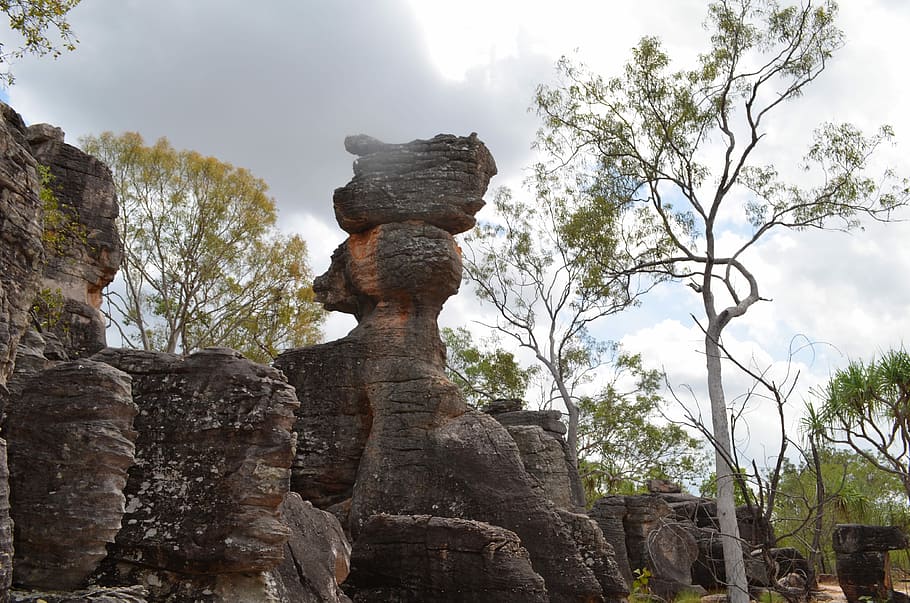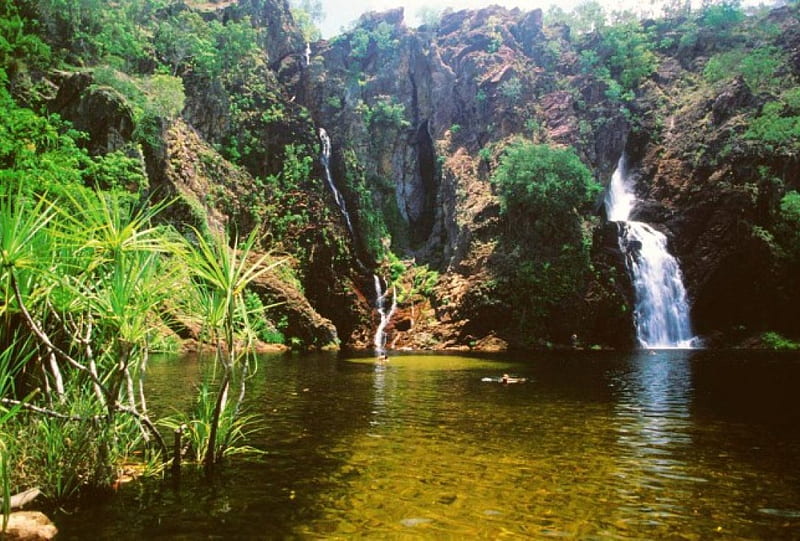Litchfield National Park

It’s a journey that will be your lasting memory, so take your time and experience the raw natural beauty of Litchfield National Park. Hit the road out of Darwin to discover the region’s stunning national parks, pristine river systems and abundance of nature and wildlife. Experience stunning landscapes carved by nature over millions of years and traditional Aboriginal communities and artworks. Litchfield National Park is just an hour-and-a-half drive from Darwin and features a myriad of diverse environments including rugged sandstone escarpments, perennial spring-fed streams, monsoon rainforest, magnetic termite mounds, waterfalls and historic ruins. This 1,500 square kilometer park was the original home of the Wagait Aboriginal people. The Finniss exploration was the first European connection to the area and the Park was named after Frederick Henry Litchfield, a member of the expedition. For 75 years until 1955, the area was the center for tin and copper mining. It then fell under a pastoral lease until it was designated a national park in 1986.
You can spend as little as 2 days in the park, taking a quick dip in each of the plunge pools and rock holes on the drive through, but to really experience the true beauty of Litchfield it’s best to stay at least 3-4 days. Litchfield National Park’s major attractions are linked by a sealed road, although a four- wheel drive is necessary to access some of the more remote natural attractions. It is also possible during the dry season to travel by four-wheel drive down the Southern Access Track to the Daly River Road.
The crystal-clear swimming holes and pleasant bushwalking trails make this park a favorite among Darwin locals. Meals and refreshments are available near Wangi Falls at Litchfield Cafe, and you can stay overnight at a number of campgrounds in the park or in the small township of Batchelor – the gateway to Litchfield.
Litchfield National Park Recommendations
Jump in a 4WD and discover the dramatic splendor of Tjaynera (Sandy Creek) Falls, Blythe Homestead Ruins and the weathered sandstone columns of the Lost City. Hundreds of two meters high magnetic termite mounds reveal the architectural feats of these intriguing insects that build their mounds aligned north and south to minimize exposure to the sun and maximize temperature control. View the spectacular double waterfall of Florence Falls set amid the monsoon forest – 160 steps lead down to the plunge pool. Cool off at Buley Rockhole, a series of cascading waterfalls and rock holes located just 80 meters from the car park. Visit Wangi Falls, one of the park’s best swimming and picnicking spots.

More Sweet Spots;
The spectacular Florence Falls cascade into a plunge pool, set in a pocket of monsoon forest. Take a refreshing dip in the plunge pool and then enjoy a scenic walk to the viewing platform high above the falls, which affords panoramic views of the open valley and the waterhole below. Open year round. Camping fees apply.
Buley Rockhole is a series of waterfalls and Rockhole’s, where you will find your own spot to swim and relax. Open all year round, camping is available with toilet facilities only and camping fees do apply.
Wangi Falls is Litchfield’s most popular and easily accessible attraction with a cafe and art center. An interpretive walk to the top of the falls commences near the pool and offers a great opportunity for photography. Wangi has a campground with all amenities including toilet, shower, kiosk and barbecue facilities. Open all year round. Swimming not always possible due to water levels. Camping fees apply.
Nestled in an open valley, luxuriant with paperbarks, the Falls can be found by walking along a 1.7 kilometer trail. Relax and enjoy the usually uncrowded plunge pool. Nine kilometers from the Southern Access Track. Open May to November and 4WD accessible only. Camping fees apply.
Surprise Creek Falls is a place to relax and enjoy a swim in an uncrowded waterfall. Camping facilities are available. 4WD access only.
Tolmer Falls cascades over high escarpments into a deep plunge pool. With a viewing platform at the top, access to the bottom of the falls has been restricted to protect the habitat of colonies of ghost bats and orange horseshoe bats. Open all year round.
The Greenant Creek Walk through rainforest leads to another attractive plunge pool which is typically uncrowded. The walk is approximately 2.7 kilometers return, of moderate level and can usually be completed in one and a half hours. Start at the bridge across Greenant Creek.
Bamboo Creek and Walker Creek
Until the early 1950s, the Park was home to several tin and copper mines and relics of this mining era can be seen at Bamboo Creek Tin Mine. What remains of the site is still in good condition. From Bamboo Creek car park it is a one kilometer walk to view the sites. Commencing from the car park, the Walker Creek Walk is a moderate level walk of approximately 3.5 kilometers return and of two hours duration.
Blyth Homestead
The historic Blyth Homestead located at the site of an old tin mine, now in ruins, serves as a reminder of the tough conditions faced by pioneers in remote areas. The Homestead has been untouched since it was abandoned in the early 1960s. Open daily. Access is by 4WD only off Sandy Creek Road, check road conditions in the tropical summer.

Magnetic Termite Mounds
One of Litchfield National Park’s most unique sights is the hundreds of termite mounds standing up to two meters high. The mounds’ thin edges point north-south minimizing their exposure to the sun, keeping the mounds cool for the termites inside. An information shelter provides a fascinating insight into these remarkable creatures and their habitat.
The Lost City
These impressive freestanding sandstone blocks and pillar formations bring to mind the ruins of a long-forgotten civilization. 4WD access only, check road conditions.
The Table Top Track
This excellent, long distance bushwalk offers the opportunity to experience the isolation of the Top End. You’ll hike through extensive woodlands, along creek lines to scenic waterfalls and pools. The 39 kilometer circuit is suitable for experienced, fit and well prepared bushwalkers willing to carry their own supplies, water, and camp with minimal facilities. Link walks connect to the Tabletop Track at Florence Falls, Greenant Creek, Wangi Falls and Walker Creek. These link walks may be used to take shorter walks on sections of the main Tabletop Track. The track is normally closed between September and March for the wet season. To access the track at this time a permit must be obtained. At other times the threat of bushfires may necessitate closure of the track. If you are planning an extended walk involving overnight camping, you must obtain a permit prior to your trip and camp only in the three designated camping spots provided along the Tabletop Track. Permits can be obtained from the Parks and Wildlife Office in Batchelor. Overnight walkers are strongly urged to register with the Overnight Walker Registration Scheme by calling 1300 650 730 Day walkers should advise someone of their intended route and expected return time. It is also recommended that your group carries a detailed topographic map of the area ‘Australia’s Northern Territory Litchfield National Park’. Copies are available from the Batchelor General Store.
Accommodation
For campers there are ultimate experiences for camping located all over the National Park. Camping fees apply so keep an eye out for the ‘Park Fees’ brochure, which is also available from Tourism Top End. Concessionaires manage most campgrounds within the park.
Banyan Tree Caravan Park
Batchelor Butterfly Farm & Tea House
Batchelor Resort
Litchfield Tourist Park
Litchfield Safari Camp
Rum Jungle Bungalows
Pandanus on Litchfield
National Park and Camping Sites
National Parks have serviced camp areas, many with onsite rangers, designated generator and non-generator sites, fresh water, toilets and shower facilities. These areas may have restrictions on length of stay and park fees may apply. See the Parks and Wildlife Commission NT website for more information about national park camping sites and fees. There can be huge distances between townships so you may have to camp on private properties or Aboriginal lands, make sure you obtain permission and permits before entering the area. Some roads are not suitable for towing a caravan and there are camping restrictions in certain areas. Please check road conditions and permit requirements with the local Park Management before you set off on your journey.
For more travel advice, visit http://www.parksandwildlife.nt.gov.au/parks/access

No comment yet, add your voice below!